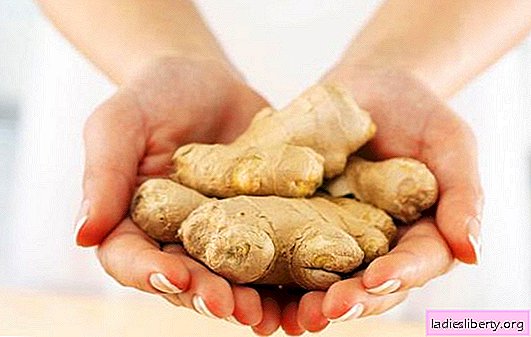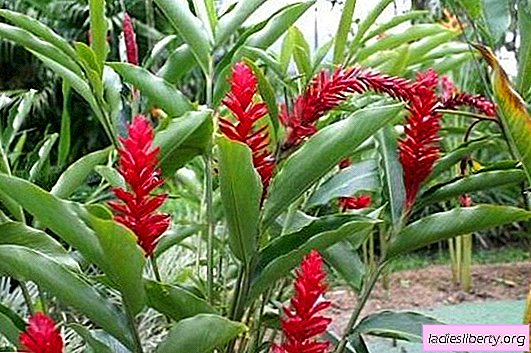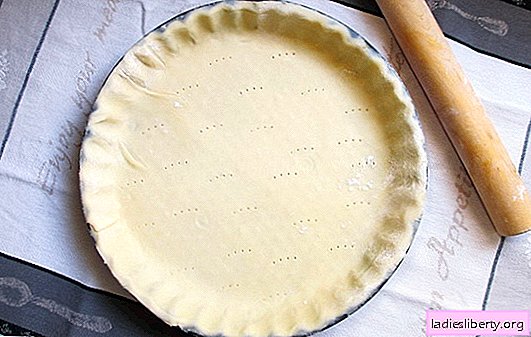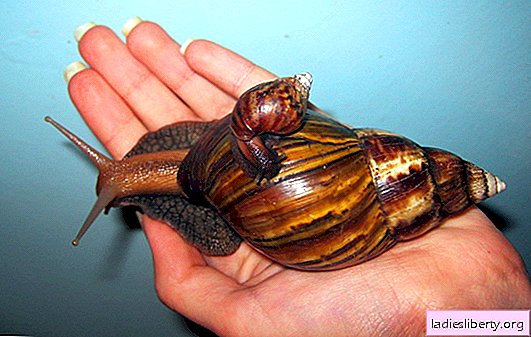
Ginger is a perennial herb native to India.
Despite his love of heat, the "horned root" is grown in many regions of our country.
It ripens for a long time - it is important that frosts do not occur until the end of September. And if climatic conditions do not allow - plant ginger at home.
The plant is rarely affected by diseases, and insects are “scared away” by its specific smell. Caring for the plantings will not take much time from the summer resident - even a layman will cope.
There is only one way to reproduce ginger - dividing the root.
Varieties of Ginger for growing
The Ginger family includes about 140 species of ginger. The plant has a thick, dense rhizome with internodes of the accessory roots.
Its aerial part consists of several erect stems with whole long leaves pointed at the ends.
A pleasant discovery for many novice gardeners will be the fact that ginger can bloom.
Inflorescences are spike-shaped, collected in leaf axils, yellow-orange or red-brown.
Growing ginger, you will not only make healing supplies for the winter, but also decorate the site.
Ginger rarely blooms in the first year of life. But if you leave it to winter in the ground, for the next season you can admire the beautiful flowers.

Blooming ginger
For a very long time, ginger has been grown as a garden crop. Breeders have bred many varieties of plants that differ in some ways:
• by the color of the rhizome - light green, yellowish, green, pale yellow with green veins;
• along the length and shape of the rhizome - elongated, "arm", "fist", "horns";
• by smell - aroma of grass, notes of lemon;
A common property characteristic of all species is a pungent taste.
All varieties of ginger, based on their method of processing rhizomes, can be divided into 2 types:
• Black (Barbados). The plant is characterized by a more burning taste and harsh aroma. Rhizomes are not cleaned, but simply processed with boiling water and dried in the sun.
• White (Bengali). Rhizomes do not have such a sharp taste. Ginger is thoroughly cleaned (in an industrial environment - aged in a weak solution of sulphurous acid) and dried.
Since the rules for growing and caring for ginger of different varieties are practically the same, when choosing planting material, focus on its taste characteristics.
Where to grow ginger?
Ginger loves warmth and sun. Try to please the new resident of the infield by planting it on the east or west side of the house. The scorching sun will harm plantings, and therefore, beds should be shaded in the daytime. Strong winds and high humidity negatively affect the development of the roots. The same rule applies to home grown ginger.
Plant likes neutral or slightly acidic, light, nutritious, well-drained soil. As a nutritious soil mixture for planting ginger, you can use the following composition - turf land, leaf humus and sand in a ratio of 1: 2: 1. No time to prepare a special substrate? Then dig over the planting zone and feed the earth with mineral fertilizers. If water is retained in the area, provide additional drainage by pouring a layer (1 cm) of gravel into the planting hole. Since the edible rhizome grows close to the surface of the earth, do not dig too deep grooves for planting material - 15-20 cm will be enough.
Ginger at home grown in shallow flat containers with a hole in the bottom to remove excess moisture. Put a layer of drainage on the bottom of the pot.
Preparing Ginger for Planting
As planting material, we will use the root of the plant. In the wild, ginger is no longer growing - there is nowhere to get seeds from. They cannot be obtained even by breeders in conditions of industrial breeding. The only thing that remains for the summer resident is to buy planting material in the vegetable market. If you want to get an "exotic" plant variety (for example, one that has a characteristic turpentine odor), you will have to look for rhizomes in specialized nurseries. Ask if they are in your area.
The best time to buy planting material is the winter months.
Quality ginger for planting:
• brilliant,
• smooth
• without traces of rot,
• not overdried,
• not frostbitten,
• with shoot buds.

Ginger root with kidney
To make the buds come to life, immediately before planting, lower the ginger roots for a couple of hours in warm water. If you are not going to plant the whole root, but only part of it, be sure to treat the cut with a potassium permanganate solution or dust it with ash.
In the future, you can do the propagation of ginger yourself. Part of the crop can be used for its intended purpose, the rest can be used to expand the beds. Dig up the rhizome, thoroughly clean it from the ground and dry it. With a sharp knife, cut the "jumper" of the root, then processing the slices. Ready planting material can be planted in the ground or stored for planting in the next season. Keep it cool - the basement is great for holding potatoes and other root vegetables.
Growing Ginger at Home
Start planting rhizomes in February-March.
The plant needs a lot of time to get stronger - just in time for the middle of summer, some copies will already be ready for use. Planting material in the hole "eyes" up. Strong him do not dig - the kidneys should be sprinkled with earth a layer of only 2-4 cm. Water the soil.
Young shoots should appear already 2-3 weeks later.
The optimum temperature for this is 18-22 ˚C. If the thermometer thermometer drop below, ginger hibernate - By the end of the season, you definitely will not see a crop of useful roots. Do not water the plant, only occasionally spraying it to prevent drying of the earth.
Ginger cultivation in an open area
Planting ginger root immediately in open ground is recommended only in warm regions of the country, where stable warm weather is established by March. But even in a temperate climate, planting material is better to germinate first at home or in a greenhouse. The rules for preparing "seedlings" of ginger are the same as in the case of cultivation at home.

Ginger sprouts
When the seedlings get stronger, and a stable high temperature is established on the street, you can transplant ginger into the garden. Do not deeply root the roots. With proper care, the plant will begin to grow actively.
Ginger Care
The main requirements for caring for ginger are plenty of light and timely watering. Many summer residents do not even feed the plants, because under favorable weather conditions it develops well without fertilizers.
There are some rules that can help you get a rich harvest of useful roots at the end of the season:
• Watering. Moisten the soil a little, but often. If the soil is overdried, the roots will die due to lack of nutrients. And at home, and in the garden in hot weather, spray the aerial parts of the plant. Do this in the evening, because in the rays of the scorching sun, drops falling on the leaves can cause burns. One week before harvesting, stop watering altogether.
• Top dressing. Ginger will be much larger and tastier if every 10-15 days during the whole growing season fertilize the earth with complex fertilizing. For the formation of tubers, use organics, and from mid-summer, also introduce potash fertilizers.
• Lighting. Despite the fact that ginger cannot grow without light, direct sunlight is destructive for him. When growing at home on hot days, carry a container of ginger in partial shade. If the balcony is not very hot, you can sometimes make the plant "breathe".
• Loosening. Rhizomes will receive more air if they regularly loosen the soil. Do this after each watering so that no crust forms on the ground. Weeding depth - 1-3 cm. If necessary, remove weeds.
In warm regions, many summer residents leave wintering ginger in the ground. To prevent the plant from dying, the air temperature should be 8-12 ˚C. In this case, the likelihood of its blooming in the next season increases significantly. If you use a greenhouse for winter planting, then ginger can be moved here for the colder months. At 17-20 ˚C, plantings will develop further. There is another option - to keep the plant in the winter at home, after replanting it in a suitable container.
When and how to harvest?
Ginger, depending on the specific variety and climatic characteristics, ripens in August or late September. By the time the rhizomes are harvested, the land without watering should already have dried out a little - this stimulates the rhizomes to additional growth. If you are not going to continue to keep the plant in the garden, you can dig in the roots.

Ginger dug from the ground
Dig ginger when the stems and leaves turn yellow and fade.
Carefully remove the healthy roots from the ground. They can be used immediately for their intended purpose - add as seasoning to dishes. And that part of the fruit that you will send for winter storage must be thoroughly cleaned from the ground (rinsing with water is allowed) and dried in a warm, well-ventilated room. It is better not to use a household oven - there is a risk of over-drying the rhizomes.
For food purposes, you can use the leaves of the plant.
Ginger roots can be stored in the basement, in a dark cupboard in the kitchen, or on the bottom shelf of the refrigerator. Here the product will lie for several months without losing its beneficial properties. If you have harvested a large crop, then the rhizomes can be frozen by packing in separate packages whole or chopped.
How to protect ginger from diseases and pests?
Ginger has a specific aroma and taste, which protects it from diseases and attacks of insect pests.
Many of the problems associated with growing ginger are associated with improper care or unsuitable conditions of detention. The plant can drop leaves, which will signal the gardener to slightly shade the plant from direct sunlight and provide abundant watering. If the water remains in the axils of leaves or inflorescences for a long time, this can lead to decay of the aerial parts of ginger.
Ginger, especially those that grow at home, may be attacked. spider mite. A small bug feeds on the juice of the plant - it is not at all "scared" by the acrid taste of green mass. You will immediately notice the presence of a spider mite on the plantings - white dots will appear on the underside of the leaves, and over time, the insect begins to braid all parts of the plant with a thin web. Optimum conditions for the pest are excessively dry air. To prevent its occurrence, you can put a jar of water near the container with ginger, which will provide additional air humidification.
Rinse the ginger overhead with water. This will help flush insects and their larvae from the foliage. Processing is subjected not only to the plant, but also to the windowsill, on which the pot stood. If washing does not help or there is a risk that the tick will affect nearby plants, use chemicals to treat the plant. Do not buy insecticides when a spider mite invades - there will be no sense. Other means will help here - insectoacaricides and acaricides. Good drugs kill pests and their larvae the first time around.
To take action in time, regularly inspect ginger for disease and the presence of insects. If other plants get sick, for prevention you can treat with protective means and beds with ginger.











